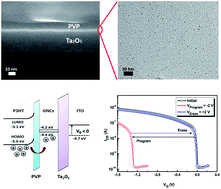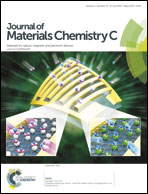High-performance organic nano-floating-gate memory devices based on graphite nanocrystals as charge-trapping elements and high-k Ta2O5 as a controlled gate dielectric
Abstract
A new type of high-performance organic nano-floating-gate memory (NFGM) device has been fabricated by integrating graphite nanocrystals (GNCs) as charge-trapping elements and high-k Ta2O5 as a controlled gate dielectric. The GNC nano-floating-gates have a high density of charge trapping sites, and they are electrically separated enabling the reduction of stored charge leakage. With a relatively low-voltage programming pulse (−2 V, 1 μs), the fabricated devices exhibit a significant negative threshold voltage shift of 1.3 V, and programming/erasing switching times of less than 10 ns are observed. Furthermore, the NFGM devices show a long retention time of more than 10 years at room temperature along with robust endurance properties with 104 cycles of repeated programming/erasing. This approach provides an outstanding alternative approach for fabricating high-performance GNC-based organic NFGM devices and opens up a new route for the development of next-generation non-volatile memory devices.


 Please wait while we load your content...
Please wait while we load your content...